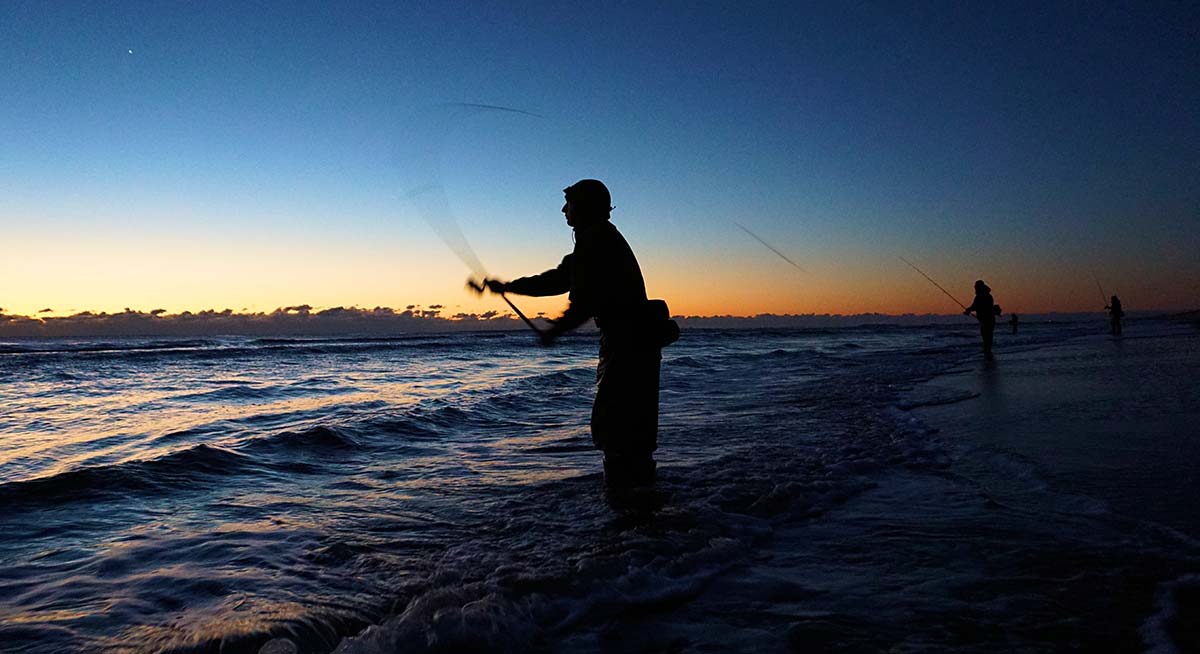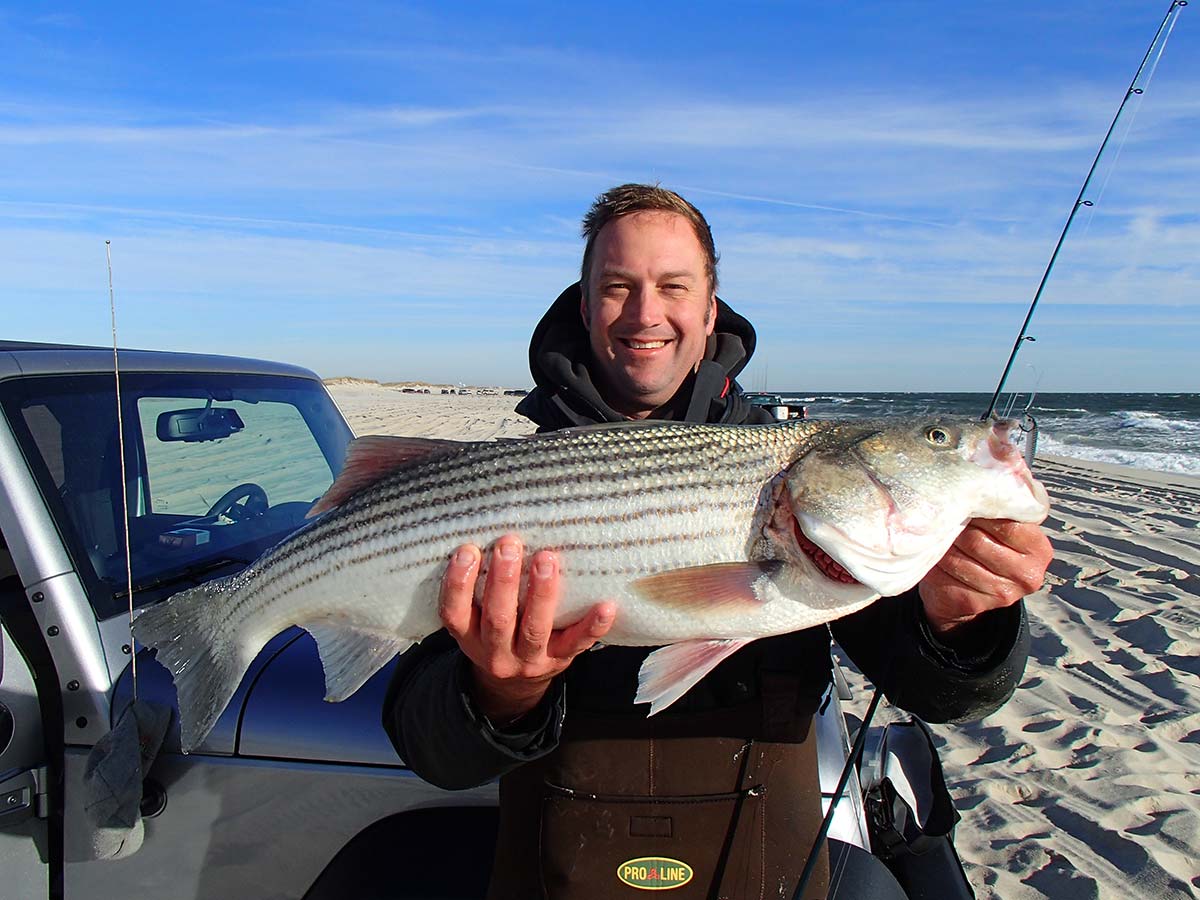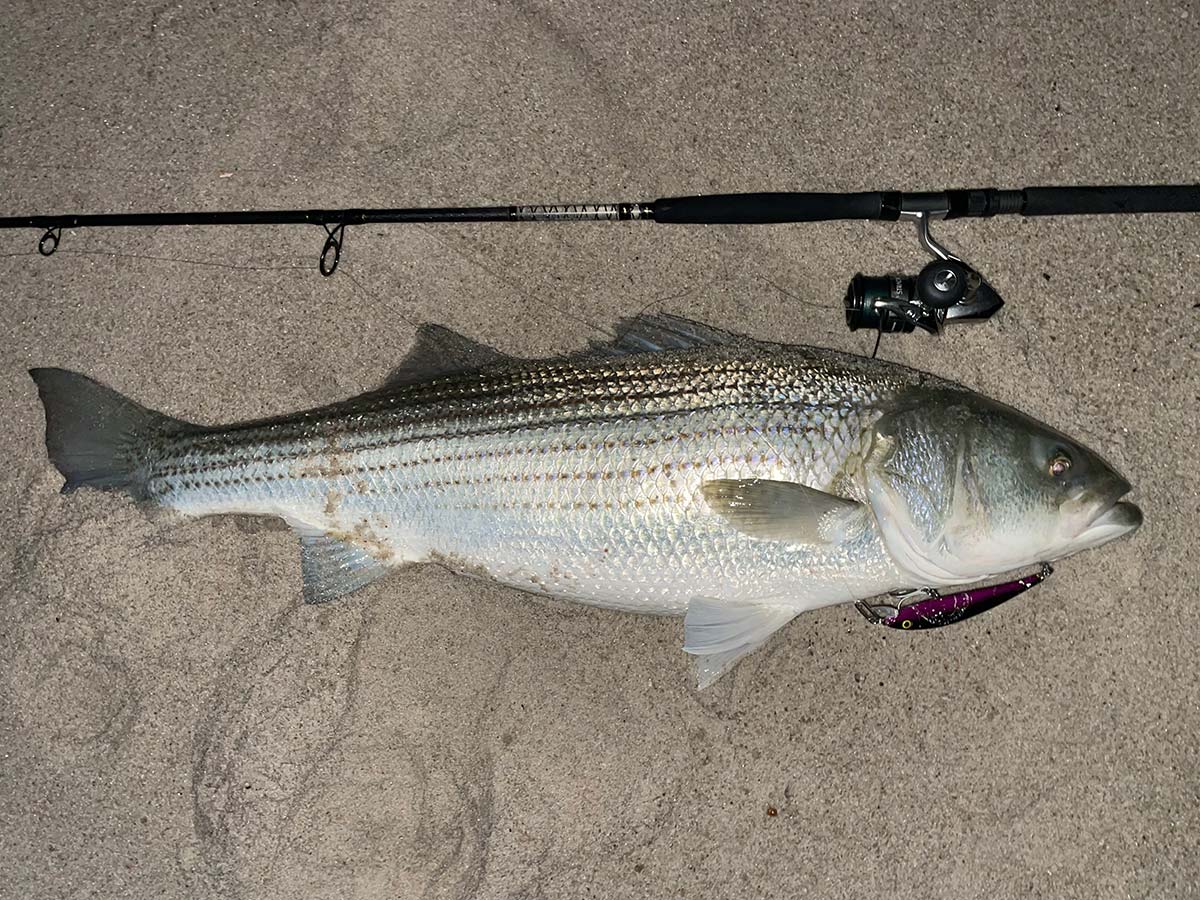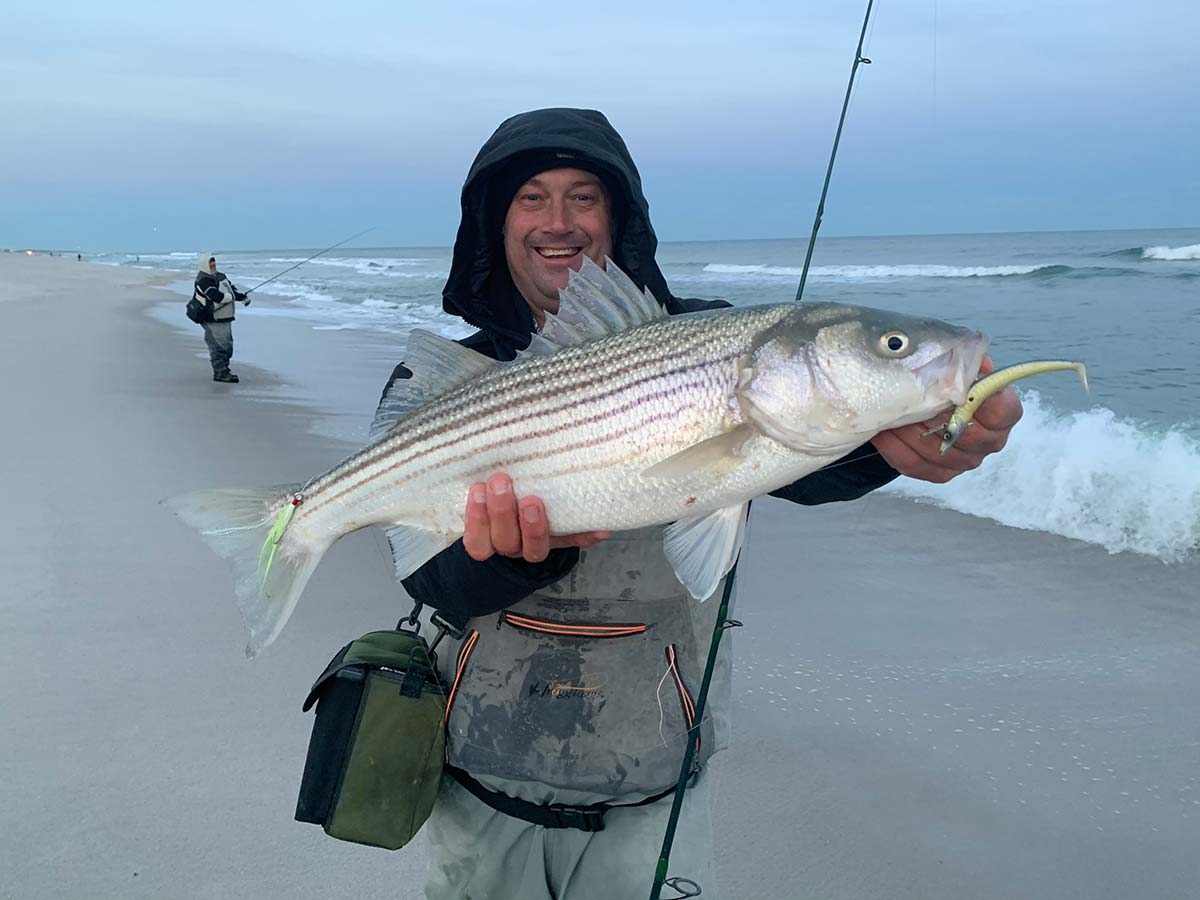
How to maximize a full 24 hours of November surf action at the Jersey Shore.
Quite possibly, no other month such as November makes me feel alive. The Atlantic is absolutely ripe with activity. Autumn’s fall run of striped bass is in full effect all throughout the surf. Gannets dive, whales breach and bait schools such as peanut bunker, spearing, sand eels and rainfish are pinned alongshore as striped bass relentlessly jackhammer the bait day and night.
With only 24 hours in a day, I put in 25 hours a day during November, never wanting to miss a blitz or a bite. Here’s my general strategy for around the clock surf sessions.
Pre Dawn (4-6 A.M.)
Get out to the beach when it’s pitch black. Quietude surrounds you on the sands as the stars are still bright in the sky. A headlamp is donned though only used when unhooking a fish or tying a knot. Reading the whitewater off the sheen of the moon, you can identify where the holes, cuts and sandbars are. Black or blurple Bomber is my go-to plug here for bass of 24 to 36 inches, but if larger model fish are around, chunky metal lipped wooden swimmers are slung. Slow is the mantra, as in so slow you barely wag the plug with each crank of the handle. The hottest bite usually occurs right before the first glint of light pervades, or as I know it, “when the constellation Orion starts to fade” in the sky behind me. Stripers are looking to be the first at the dinner table and many of the larger fish are caught before the schoolies move in at sunup.

Sunrise (6-9 A.M.)
Before the actual sunrise, when the predawn orange and purple glow begins to paint the horizon, sand eels begin to emerge from the sea floor. Slender metals such as Ava 007 to 17 jigs with green or black tails and Deadly Dicks are clipped on, casted out and dragged slowly along the sand where bass pick off the sand eels as they poke their heads up and extract themselves. Rubber baits like the Tsunami Sand Eel also perfectly mimic the baits. As the sun breaks the horizon, I’ll speed up my retrieve just a bit as the eels are now swimming in the bottom and mid-range water column. A small 3/0 bucktail teaser or Felmlee eel can also be 20 inches above the lure. Rubber Storm or Tsunami shads also clean up at this time, especially if peanut bunker are more prevalent than the sand eels. As the sun warms the top of the ocean surface, topwater poppers such as the Savage Gear Panic Popper or Stillwater Smack-It will get bone-jarring strikes. Many fish hit on the inside of a sand bar as the water washes over into the cut.
Late Morning (9 Til’ Noon)
Now’s the time to run and gun, especially if you have a beach buggy. Chasing the blitzes is the modus operandi here. Stripers are getting aggressive as the surface temps have elevated a few degrees by now and will actively pursue and hunt down bait schools. I generally work a 15-mile stretch, popping in and out town to town to see birds diving from the height of the dune systems, or if in a buggy, always looking north and south for bird play. Poppers and plugs in lighter color patterns like white, yellow and olive as well as metals will all work now and usually I’ll bring out a longer 9- to 11-foot rod capable of tossing lures up to 3 ounces to reach the outer bars where plenty of frustrating blitzes happen just out of range of a smaller 7- to 8-foot rod. During low tide hours, walk out and work the outer ocean, but be mindful of incoming water, lest you get trapped and have to remove the waders to swim back. You may only be knee deep in water on the bar, but water fills up quick in the sloughs behind you. Once water hits my upper knees, I’m back on the beach.

Afternoon (Noon To 4 P.M.)
This period is usually the down time of most any day, but by no means is it unproductive. On good days, bass will blitz throughout the afternoon, as they did last year for a three-day stretch in late November. However, generally, it’s all about identifying and exploring different holes to find hanging stripers, using bucktails and rubber shads to work the cuts and sloughs. If low tide is around, walk out on the bar and cast into the slope. It’s a good time to recharge and eat your lunch, but stay vigilant for blitzes that can pop up at any given moment.
Evening (4 To 6 P.M.)
The real witching hour starts. Bass begin to get aggro once again as their eyesight keys in more easily on baitfish with darkness falling. I’ll reflect on where I caught fish in the sunrise hours and usually gravitate back to that spot as I know the bass will come in once again on a same pattern to feed. Generally, I stay with that spot for the evening, walking a couple hundred yards north and south until I find the fish. As darkness truly falls, many anglers make a huge mistake and leave the beach. The bite might get quiet right when it gets pitch dark, but within 40 minutes the chew picks right up again, usually for a good two hours. I can’t tell you how many times I shake my head when I see people leaving the beach at nightfall. After that bonus bite, it does tend to get a bit quiet until around 8 p.m., then the real magic begin.

Night Shift (6 P.M. To 4 A.M.)
It’s silent assassin time. Surf ninja skills are needed to navigate the night shift, especially on new moon nights when its “Darker’n a black steer’s tookus on a moonless prairie night,” to rip a quote from Sam Elliot in The Big Lebowski. This is the time to tally up dozens and dozens of fish, if not more. Speaking generally, the 8 p.m. to midnight time frame is usually the hottest time, and of course even more so if times of high water falls within that constraint. I usually use a landmark such as a water tower or streetlight to identify my hot spots to fish at night, but it has to be exact. You could be 50 yards away and not be into fish.
Black and dark colored plugs reign supreme here, though my teaser is usually of a stark white color to test the bite and see if the bass are hitting contrasting presentations and will adapt accordingly. Reel your plug in as slow as you possibly can while keeping minute pressure on it just enough to keep contact and make it wiggle. Endless casts will eventually get you into fish, but if you do hook up, work that hole relentlessly as one bass usually means more bass hanging in that hole. If I don’t get hits 45 minutes after my last fish, I’ll pick up and move to another cut. Conversely, if I miss a fish or two in a hole, I’ll let it sit for an hour then come back to it and plant the hook back into the same fish I missed. It happens frequently. The slow time usually happens from 1 a.m. to 3 p.m., but not always as I’ve had tight lines that kept me out there to start it all over again at sunrise.
It can come at any time. Once the grip of the fall run gets its hands on you, all sense of time gets distorted. You’ll find yourself fishing around the clock and not knowing where the day starts and where it ends. Sleep is only a commodity for the faint of heart, though if I were to shut my eyes, it would probably be during the 1 to 3 p.m. timeframe. If you only have mornings or evenings to fish, plan on going to work late during times of high tides at sunup and sundown.
Remember, when you’re not out there, that’s when the best bite happens. Plan accordingly.




